
© Erik Tomasson. (Click image for larger version)
San Francisco Ballet
Program 2 – Bright Fast Cool Blue: Serenade, The Chairman Dances–Quartet for Two, Rodeo: Four Dance Episodes
★★★✰✰
San Francisco, War Memorial Opera House
13 February 2018
www.sfballet.org
January’s end always signals a beginning at San Francisco Ballet (SFB) – the start of the company’s annual repertory season. And once the season gets underway, things move quickly. Program 1 is already a memory, and this week San Francisco Ballet shifts into mixed repertory gear, opening two different triple bills.
Tuesday night at the War Memorial Opera House saw the first performance of Program 2’s ‘Bright Fast Cool Blue’, which joins George Balanchine’s Serenade, Benjamin Millepied’s The Chairman Dances–Quartet for Two and Justin Peck’s Rodeo: Four Dance Episodes. In terms of design, all three had definitive themes of blue, the robin egg hued tulle and cyclorama in Serenade, the cobalt costuming in opening of The Chairman Dances, the grayish-steel draped wings in Rodeo. But what about the other adjectives in the program’s title? Perhaps some in the audience saw brightness, speed and coolness in all three works. For me, it was more of a one-to-one ratio – one bright, one fast and one cool ballet – if in this program, the cool came first, Balanchine’s Serenade.
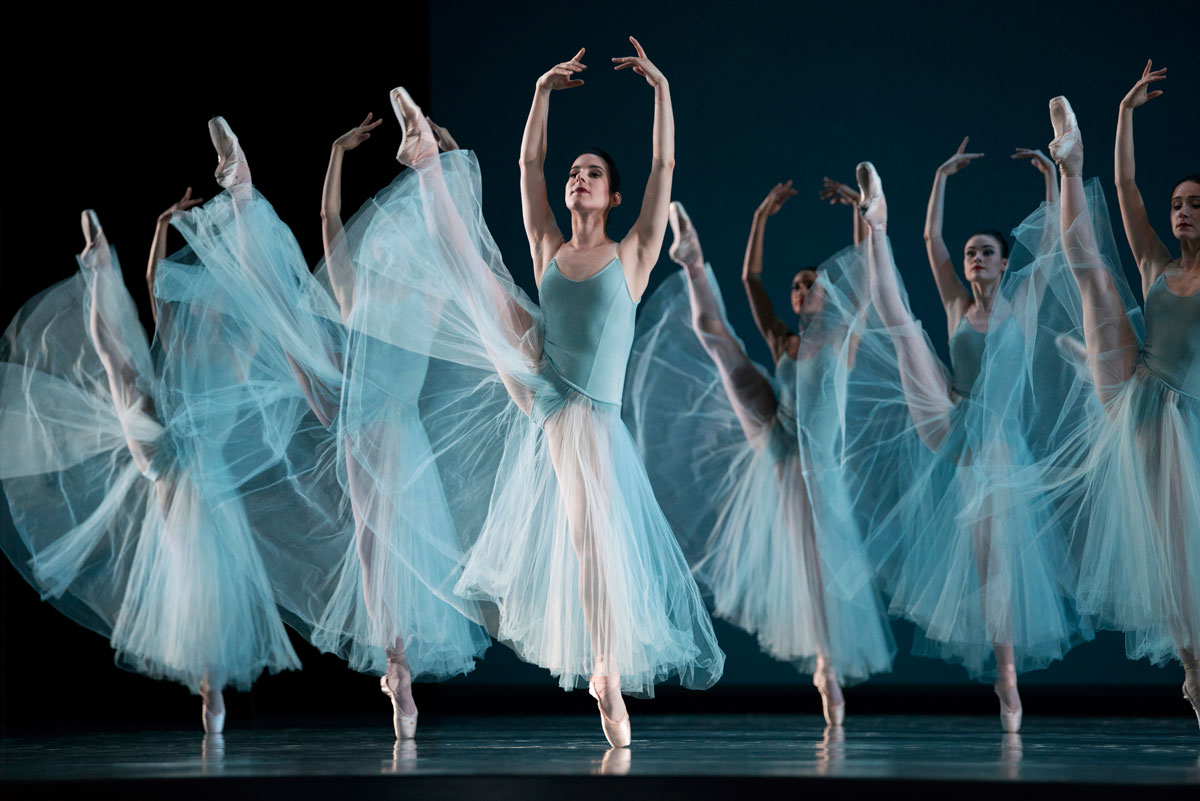
© Erik Tomasson. (Click image for larger version)
Choreographed over eighty years ago for five principals (three women, two men) and a large ensemble (seventeen women, four men), the neo-classical icon takes the viewer to the sophisticated side of cool. Serenade is a tribute to ballet vocabulary, and to the dialogue between Balanchine’s movement and Tchaikovsky’s composition. Being one of the most popular one-act ballets for over eight decades (many would argue the most popular of all), much has been written about Serenade’s structure, abstraction and choreographic vocabulary. But what of this particular performance?
For me the SFB women’s corps elegantly set the scene with the very first phrase – a flexed hand moving to the forehead, traveling to a low curve and then the staccato turning out of the feet. From there, the corps move through a series of sculptural vignettes, with acute attention to space, line and dynamics. They pierce the air with their circular turns. Arms expanded mirroring the musical crescendos, and large poses adde further emphasis to the accented chords.

© Erik Tomasson. (Click image for larger version)
As the Angel character, Jennifer Stahl had a commanding presence, whether lifting her arms in a high V or in her luxurious promenade (with Luke Ingham) in the ballet’s last minutes. In Serenade’s main duet, audiences were treated to Yuan Yuan Tan’s sky-high extensions and Carlo Di Lanno’s attentive partnering. However on opening night, something felt off. Their approach to Balanchine’s choreography was indeed musical, no question. But at the same time, they often seemed behind the music, rushing to fit steps in before the downbeat of the next measure. As a result, the movement read unevenly.
It was Mathilde Froustey that stole this performance of Serenade. Absolutely remarkable, with technique emanating from another dimension – suspended balances, precise directional changes, turns that finished with the accent up rather than down. Froustey soared through Balanchine’s choreography, and in her solos and variations, the focus wasn’t solely on the final shapes (though they were impressive). Froustey danced the transitions.

© Erik Tomasson. (Click image for larger version)
As three men walked out onto the stage’s apron in front of the main curtain, you could tell that the next ballet was going to be something new, something fresh, something bright. And it was, at least until the second half. The Chairman Dances–Quartet for Two, choreographed in 2017 by Millepied (Founder and Artistic Director of L.A. Dance Project), shone in its first movement. Set to a score by John Adams, the stage was abuzz with vigor and activity. Balletic vocabulary was injected with an innovative athleticism. Legs extended backwards in stylized running jumps; daring, diving lifts made you catch your breath. Movement emerged out of the wings, suggesting that it was already in process well before it hit the main space. And later in the ballet, those wings would rise, revealing that offstage choreography. The Chairman’s cast would bind together in large pictures and cluster shapes, the bright spotlights at the front producing shadows that added even more bodies to the exciting scene. Interspersed throughout the first movement were several featured duets, performed by Maria Kochetkova and Di Lanno. While beautifully danced and filled with the same captivating athletic quality, it was hard to compete with the phenomenal stage energy created by the whole ensemble..

© Erik Tomasson. (Click image for larger version)
Then The Chairman Dances shifted. Completely. For the second part of the work, Millepied layered three duets: one for a man and a woman, one for two men and one for two women. Costumed in flowing white tunics, arms reached out in searching, legs circled out away from the core. Hands clasped and dancers embraced in kindness and acceptance. While emotive and poignant, this section and part one were totally disconnected, like two separate works. If there was a thread or throughline uniting the two, I couldn’t find it.
Program 2 had opened with a work danced by twenty women and two men, and concluded with one that had an opposite kind of casting – fifteen men and one woman. If the title and Aaron Copland’s score had you expecting a meditation on Agnes de Mille’s 1942 Rodeo, you were in for something a little different. And it was a magnificent treat. The curtain rose on Justin Peck’s Rodeo: Four Dance Episodes to find the ensemble crouched in a runner’s start position on the side of the stage, their athletic team costuming (shirts, shorts and striped high socks) adding to the mood. Like the start of a race, they took off at full-speed, running to the other side of the stage. Here was the fast ballet. The opening of the 2015 piece, created by the New York City Ballet Soloist and Resident Choreographer, was replete with fast footwork, fast legs, fast partnering and fast turns. When the cast moved in unison, there was a joyful community spirit. And as Dores André entered the picture with sprightly jumps and crisp poses, a new addition was welcomed to the team.
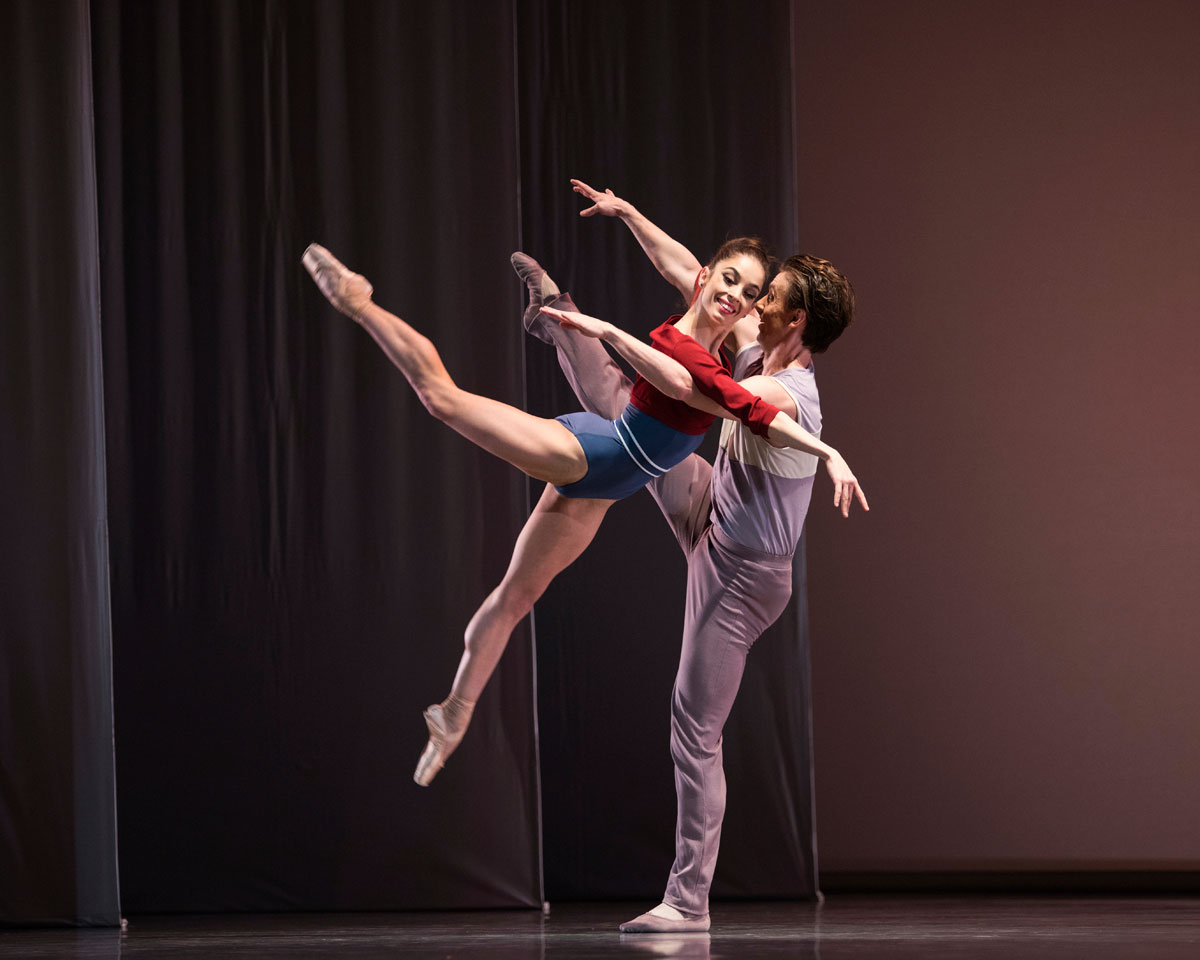
© Erik Tomasson. (Click image for larger version)
Important to note that not every sequence and variation in Rodeo was fast, at least not in a literal sense. But the slower chapters still had a connection to the word – they captured the notion of ‘holding fast’, the cast enduring in the camaraderie that had been built thus far. A quintet explored the space, coming together in statuesque formations, and supporting each other in lifts and balances. Then, André and new company Principal Ulrik Birkkjaer took the stage in Rodeo’s primary duet. Not all, but many pas de deuxs have a romantic subtext, whether intentional or not. But here Peck has crafted a pas de deux celebrating introductions and the process of getting to know another person. They were learning about the other, showing personality through movement, like André’s exuberant leg kicks. Subtle circles of the body early on led to radiant lifted turns as the pair gained a deeper sense of knowing. And as the pas de deux ended, they took hands and said farewell, happy to have shared this acquainting moment and having grown in friendship.













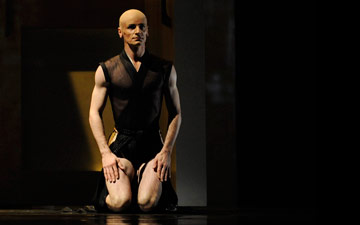

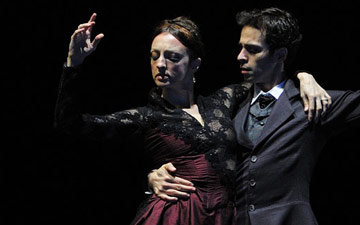
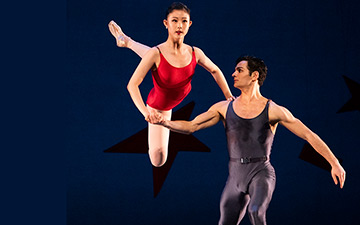
You must be logged in to post a comment.